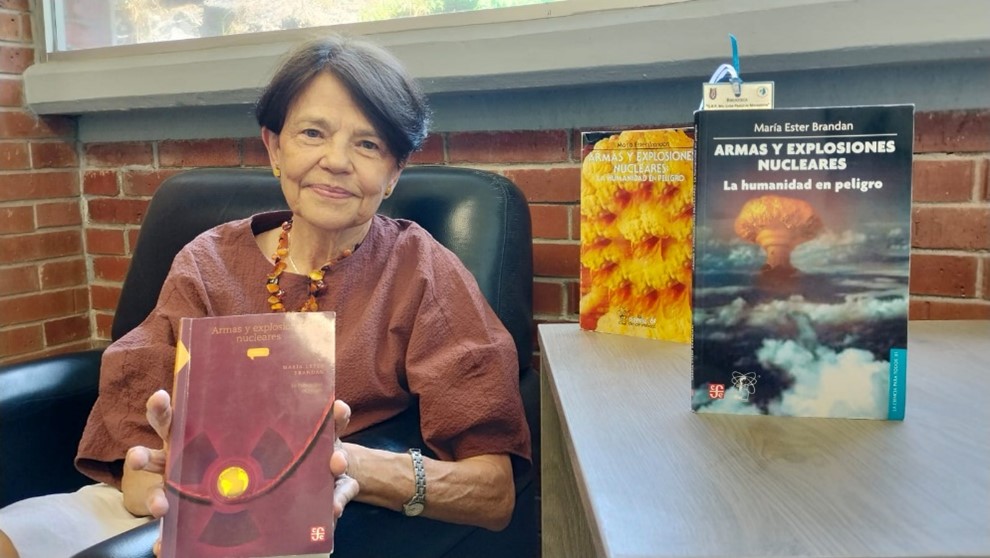【Mexico City INPS Japan=Guillermo Ayala Alanis】
María Ester Brandan is an expert in nuclear physics who exemplifies how devastating the use of a nuclear weapon would be in a city like Mexico.
“Explaining in an extremely simple way some complex topics such as the definition of a nuclear bomb, how it works, and the devastating consequences for the planet and living beings was the challenge that inspired the scientist and specialist in nuclear physics, María Ester Brandan, to write the book Nuclear Weapons and Explosions: Humanity in Danger (Armas y explosiones nucleares: La humanidad en peligro). The text was published for the first time in 1988 by Fondo de Cultura Económica (FCE) as part of the collection Science for Everyone (La ciencia para todos), which aims to bring students and readers without scientific training closer to complex topics so that they can understand them and spread the knowledge among friends and family.(P-07)|SPANISH|JAPANESE|KOREAN|
The current international context, where the danger of nuclear war is very real, has helped to keep the book in the interest of young readers, even though it was written in a different era. As Professor Brandan commented in an interview for INPS Japan: “Its essential content continues… every day we are more concerned or frightened by the possibility of nuclear weapons being used, depending on a handful of people… I would like society to reflect that everything that has been built as humanity, as homo sapiens, can be lost at the push of a button.”
The idea for the book came more than 40 years ago in her native Chile when, in 1983, Professor Brandan read a text about the consequences and devastation of a hypothetical nuclear explosion of 1 megaton (1 million tons of TNT) in New York. Months later, she came up with the idea of taking the references and adapting them to the city of Santiago in an article for a popular scientific magazine. Once in Mexico, to write the book, she made the same adaptation and named one of the chapters “A Megaton Over Mexico City.” With precision, she details that a nuclear bomb would fall 2,000 meters above the center of the Mexican capital and within a few seconds, a ball of hot and luminous fire would form, which combined with the shock wave, would devastate a large part of the metropolis, currently home to 22 million people.
With more than 30 years of living in Mexico, María Ester Brandan, who is dedicated to the study of nuclear physics, works at the National Autonomous University of Mexico (UNAM) and says she is proud of the research carried out for the book Nuclear Weapons and Explosions because the technical and historical research retains legitimacy and relevance, despite the fact that today there is more information and openness of classified texts and films such as Oppenheimer.

The book has sold more than 52 thousand copies and is one of the most popular texts in the Science for Everyone collection. The author acknowledged the work of the FCE in promoting it and also its readers who have been interested in transmitting knowledge among friends and family. As an anecdote, she told a story of a high school student who had the task of writing an essay and a summary of the book but was so impressed by the topic of nuclear weapons that he spread it among his parents and relatives, making it the main topic at dinner time for several days.
She also commented that she has been fortunate to find copies of the book in public schools outside of Mexico, such as in Cuba and Chile. “We were traveling through the south of Chile to a city called Chillán, where there is a public school called Escuela México. My husband is Mexican, and so we decided with our daughters that we had to go to Escuela México because in that place, David Alfaro Siqueiros had painted a mural in the library during his exile… When I saw the mural and books that came from Mexico in the library, I realized that my book was there. The same thing happened to me in Havana,” María Ester Brandan commented.
The creativity in the work was not only limited to explaining with ease the complexity of nuclear weapons and the devastation of the world. The covers have also been the result of the talent and effort of designers. In the 36 years that the book has been published, three covers have been released. Professor Brandan explained that she feels a special appreciation for the first one because of the originality with which it was made, using cauliflowers and orange paper to recreate the nuclear explosion.
She also recognized the cover of the latest edition that puts the planet Earth on a tightrope before the symbol of radioactivity.
Regarding the future of nuclear war, Brandan was pessimistic and assured that it is a very critical and terribly dangerous moment. She emphasized that there are no better words to describe what humanity is experiencing today regarding nuclear weapons than a quote from Gabriel García Márquez:
“Since the appearance of visible life on Earth, it took 380 million years for a butterfly to learn to fly, another 180 million years to make a rose with no other commitment than to be beautiful, and four geological eras for human beings, unlike the great-grandfather pitecanthropus, to be able to sing better than birds and to die of love. It is nothing honorable for human talent, in the golden age of science, to have conceived the way in which such a wasteful and colossal millenary process could return to nothingness from whence it came by the simple art of pressing a button.”
Currently, María Ester Brandan is dedicated to the research of nuclear physics for medical purposes at the Institute of Physics of the UNAM.”
This article is brought to you by INPS Japan in collaboration with Soka Gakkai International in consultative status with UN ECOSOC.
INPS Japan
Related Articles:





